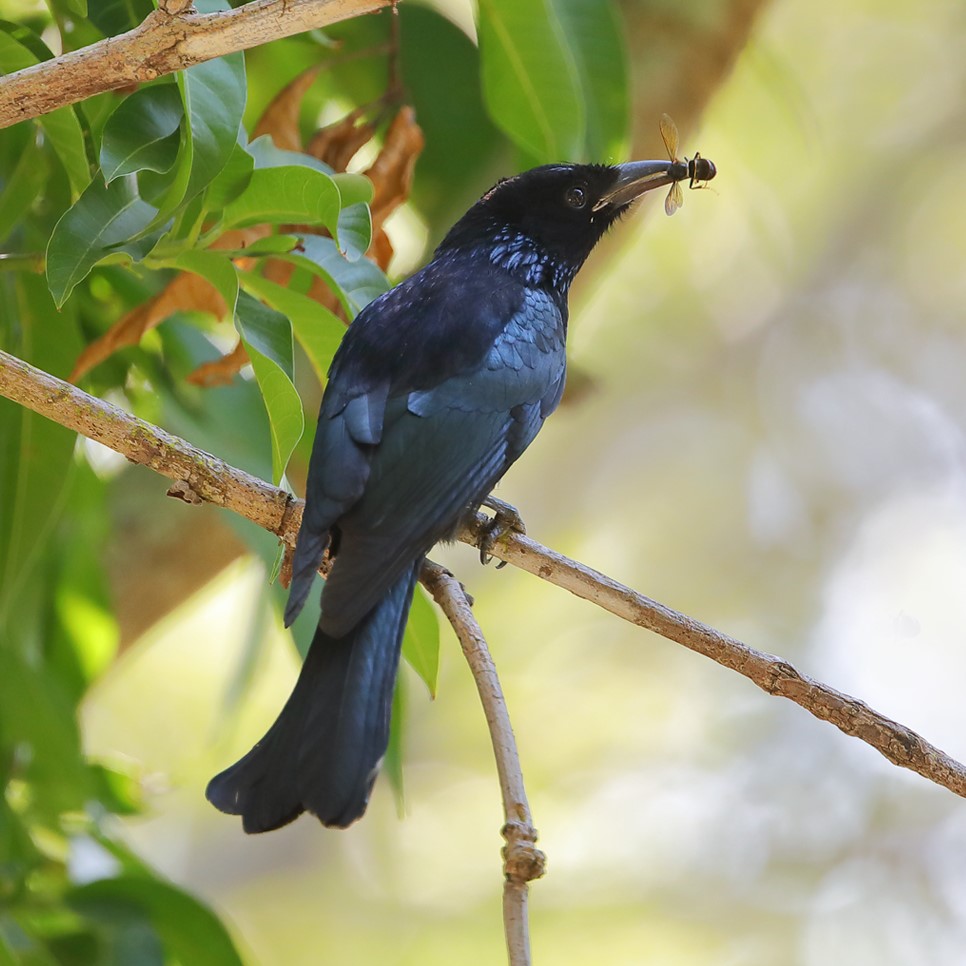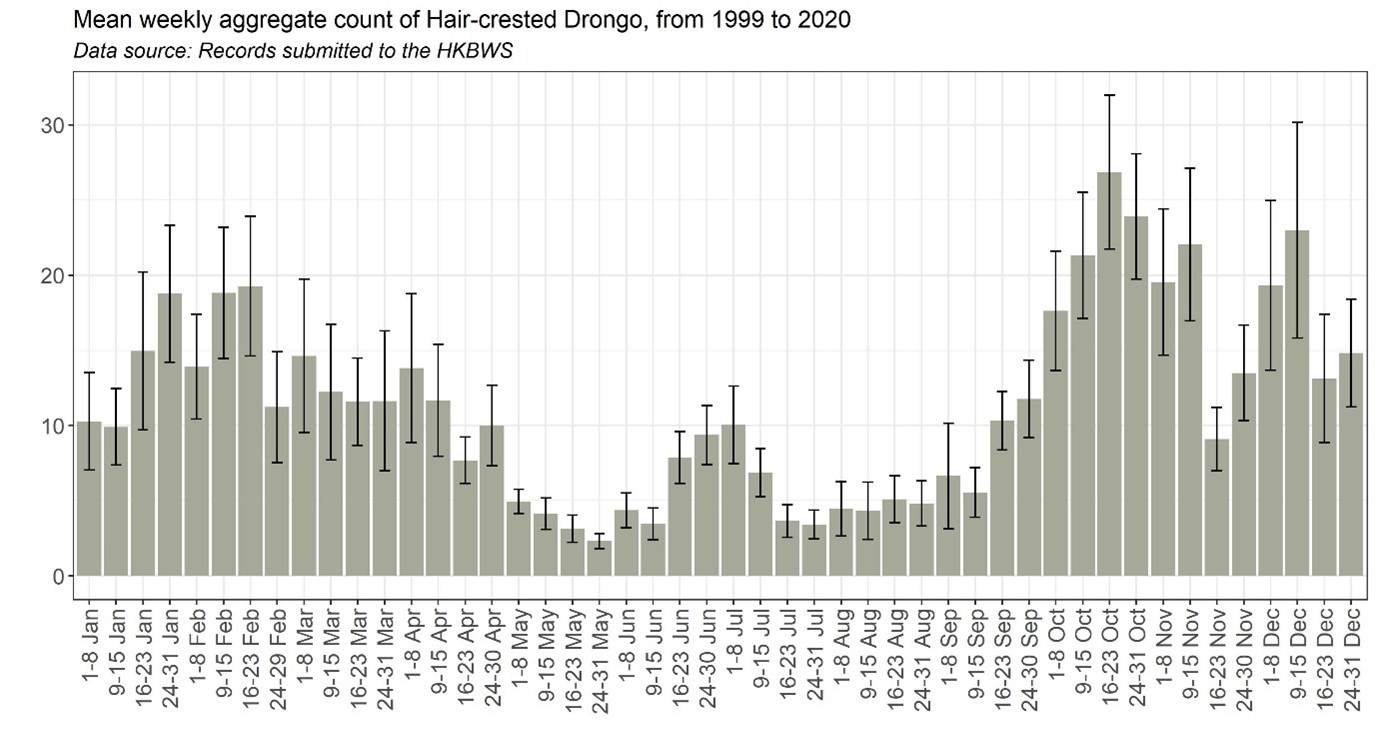Hair-crested Drongo Dicrurus hottentottus 髮冠卷尾
Category I. Occurs year-round in open broadleaf woodland or forest-edge areas, most abundant during autumn passage.
IDENTIFICATION

Oct. 2008, Michelle and Peter Wong.
28-32 cm. Plumage blackish, glossed metallic blue-green. Long hair-like feathers emerge from forehead and extend over hind crown and upper back. Bill noticeably pointed and downcurved. Female is like male, but duller, less velvety and usually smaller.

Dec. 2019, Michelle and Peter Wong.
Tail appears no more than slightly forked at rest and has strongly upturned outer tail feathers.
Juvenile is browner and less glossed than adult, with shorter frontal filaments, shorter hackle feathers of breast and neck and white-tipped axillaries and underwing-coverts.
VOCALISATIONS
Commonly utters a ‘chee-oo’ or ‘chee-up’ call similar to that of Ashy Drongo, but slightly lower-pitched and fuller. This may be interspersed with short, sharply downslurred ‘chup.’
The song varies among individuals and is diverse in character. It often contains the typical call note, the flight call and an array of harsh and pure notes.
The flight call is low ‘chup’ or ‘chip,’ often rather quiet.
DISTRIBUTION & HABITAT PREFERENCE
Widespread, but more likely to occur in northern New Territories, Sai Kung and wooded areas on HK Island and Lantau. More frequent in broadleaf woodland, but also regular in less-wooded areas such as large gardens and copses. In the breeding season, it occurs in the larger areas of broadleaf forest in the central New Territories but primarily at the fringes, and numbers tend to be higher in less homogenous areas such as fung shui woods, shelter belts and catchwater plantations. There is an obvious passage population (e.g., on Po Toi) that is often mixed with the wintering/breeding population.
There was a decline in its range as measured by the breeding bird surveys of 1993-96 and 2016-19, with 1km square occupancy declining from 12.3% to 5.3%. Previously more widespread in Tai Mo Shan massif, HK Island and Lantau, it has become absent from many parts of these areas in recent decades. This is likely a result of increased closed-canopy forest cover, and thus the drier northwest slopes of the Tai Mo Shan massif remain favoured.
There was a slight increase in its non-breeding range between the winter atlas of 2001-05 and that of 2016-19 from 3.4% of 1km squares in the former to 5.6% in the latter.
OCCURRENCE
Hair-crested Drongo is a scarce breeding species, common passage migrant and uncommon winter visitor, though it is unknown if any birds are actually resident. Numbers are highest during autumn passage, mainly October and the first half of November (Figure 1), with the highest count being 52 on 15 November 2017. On Po Toi, where Hair-crested Drongo is not known to breed and is rare in winter, up to 26 (though usually single figures) occur from the end of August, with numbers petering out in December.
A greater propensity to form flocks in winter means that the highest counts on record have occurred in the cool months, often along the Shek Kong catchment: 108 on 15 December 2019, 71 on 19 February 2018 and 69 on 15 December 2012.
Spring passage is weak and, at most sites, difficult to distinguish from departing winter birds or the arrival of the breeding population. Single figure counts are typical, but up to 15 have been noted at sites where breeding is unusual. On Po Toi migrants typically occur from the last week of March to the middle of May usually in flocks of up to five birds. Numbers are low from May to August, partly due to reduced observer activity and/or a reduced likelihood of forming large groups, but no doubt also lower abundance.
Hair-crested Drongo was not observed by Swinhoe (1861), nor was it known from HK by Vaughan and Jones (1913). However, it is likely that numbers increased with the maturation of plantation and natural woodland in the early twentieth century, as it was considered a common summer visitor by Herklots (1938). There seem to have been no major changes in numbers since the 1930s, though as has been noted for some other species, the disappearance since the 1970s of open country between the urban area and the forested hills in the west of Hong Kong Island appears to have resulted in the local disappearance of birds that previously occupied this ecotone.
BEHAVIOUR, FORAGING & DIET
Occurs in small parties and mixed flocks, often with Greater Necklaced Laughingthrushes or Grey Treepies. Forms largest flocks in winter, but also during autumn passage. Omnivorous, mostly arboreal, known to feed on insects such as hoverflies, moths and praying mantis, and also pollen or nectar from Peltophorum pterocarpum, Rhodoleia championii, Spathodea campanulata, Dalbergia assamica, flowering Eucalyptus (Barretto and Barretto 2022) and Bombax malabaricum.
BREEDING
Hair-crested Drongos begin to pair up and start breeding in April, and fledglings are observed from May to late July. Previously Tai Po Kau was estimated to support up to 15 pairs in different years, but the number has apparently declined in recent decades, probably because of the maturation of the secondary forest and reduction in woodland edge habitat. Siu Lam near Tuen Mun has supported a high number of breeding pairs this century, with more than ten in the period from 2000 to 2011. Other semi-open habitats in the northern New Territories also favour the breeding of Hair-crested Drongo, such as Tai Tong, Shuen Wan and Fanling Golf Course. They are aggressive in defending the nest from avian predators.
RANGE & SYSTEMATICS
D. t. brevirostris, which is the only race that occurs in HK, breeds in central and south China from Hebei south, north Myanmar, north Laos and north and central Vietnam; it winters throughout Indochina, Thailand and lower Myanmar (Rocamora et al. 2020).
CONSERVATION STATUS
IUCN: Least Concern. Population trend unknown.
Figure 1.

Barretto, K. and R. Barretto (2022). Bird of the Month. Hair-crested Drongo Dicrurus hottentottus brevirostris. Hong Kong Gardening Society Newsletter, June 2022: 5-7.
Herklots, G. A. C. (1938). The birds of Hong Kong. Part XXCIII. Family Dicuridae, drongos. Hong Kong Naturalist 8: 154-156.
Rocamora, G., J. del Hoyo, N. Collar, D. Yeatman-Berthelot, D. A. Christie, and G. M. Kirwan (2020). Hair-crested Drongo (Dicrurus hottentottus), version 1.0. In Birds of the World (S. M. Billerman, B. K. Keeney, P. G. Rodewald, and T. S. Schulenberg, Editors). Cornell Lab of Ornithology, Ithaca, NY, USA. https://doi.org/10.2173/bow.hacdro1.01
Swinhoe, R. (1861). Notes on the ornithology of Hong Kong, Macao and Canton, made during the latter end of February, March, April, and the beginning of May 1860. Ibis 1861: 23-57.
Vaughan, R. E. and K. H. Jones (1913). The birds of Hong Kong, Macao and the West River or Si Kiang in South-East China, with special reference to their nidification and seasonal movements. Ibis 1913: 17-76, 163-201, 351-384.

